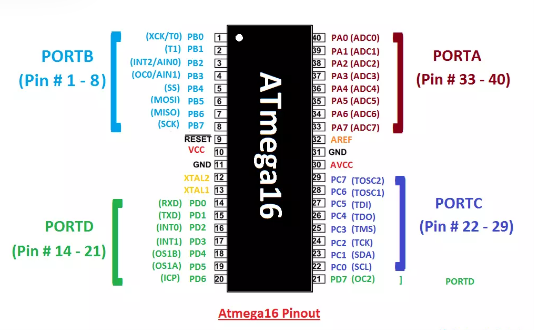


I trust you're well. Embedded systems owe much to the pivotal role of microcontrollers, especially in automated setups. Today, I'll delve into the essentials of Atmega16, shedding light on its specifications. This 40-pin, low-power 8-bit microcontroller is crafted using CMOS technology and adopts the AVR architecture. It stands as a cornerstone within the Atmel Mega family, widely employed in various applications. Additionally, I recommend examining Atmega328, another prominent member of the Mega family. Other noteworthy AVR microcontrollers include Atmega8 and Atmega32, each varying primarily in memory capacity and cost. I aim to provide an exhaustive overview of this controller, consolidating all pertinent information in one place. Let's embark on this journey, exploring its functionality, key features, pin configuration, and more.
Atmega16 represents a 40-pin microcontroller engineered using CMOS technology, renowned for its low power consumption and robust noise immunity. This 8-bit marvel operates on AVR's advanced RISC architecture, a lineage of microcontrollers pioneered by Atmel back in 1996. It encapsulates a full-fledged computing unit featuring CPU, ROM, RAM, EEPROM, timers, counters, ADC, and four 8-bit ports designated as PORTA, PORTB, PORTC, and PORTD, each hosting 8 I/O pins.
This microcontroller integrates registers to facilitate communication between the CPU and external peripherals, enabling seamless input and output operations. Notably, Atmega16 boasts two 8-bit timers and a single 16-bit timer, all of which can be repurposed as counters for external signal monitoring.
Equipped with essential peripherals like ADC, analog comparator, USART, and SPI, Atmega16 stands as a cost-effective alternative to microprocessors, which often necessitate external peripherals for various functions. Its onboard 1KB static RAM offers volatile memory storage, reliant on consistent power supply, while the 16KB flash memory, also referred to as ROM, ensures non-volatile data retention even in the absence of power, safeguarding critical information.
Operating at a maximum frequency of 16MHz, Atmega16 executes instructions swiftly within a single machine cycle, facilitating efficient performance across diverse applications.
The structural design of Atmega16, depicted in the accompanying diagram, adheres to the Harvard Architecture principle, featuring distinct buses and memory units. Program instructions are housed within the program memory, ensuring efficient and segregated data flow within the system.

1. Processor:
The CPU serves as the central processing unit, functioning akin to the controller's brain, overseeing the execution of numerous instructions. It manages interrupts, conducts calculations, and orchestrates peripheral control through its registers. Within Atmega16, it interfaces with two distinct buses: the instruction bus for reading instructions, and the data bus for accessing or modifying corresponding data. Key components of the CPU include the program counter, general-purpose registers, stack pointer, instruction register, and instruction decoder.
2. Program Memory:
The controller's program resides in ROM, also referred to as non-volatile programmable flash memory. This flash memory boasts a minimum resolution of 10,000 write/erase cycles and is typically divided into two segments: the Application flash section, housing the controller's program, and the Boot flash section, optimized for immediate execution upon powering up the controller.
3. Temporary Memory:
SRAM, or static random-access memory, temporarily stores information and comprises 8-bit registers. Analogous to conventional computer RAM, SRAM facilitates data manipulation during runtime.
4. Long-Term Storage:
EEPROM, or Electronically Erasable Read-Only Memory, serves as non-volatile memory for long-term storage, storing system configurations and device parameters independently of program execution. Despite not directly participating in program execution, EEPROM offers limited write cycles, typically up to 100,000, with unlimited read cycles. It's prudent to minimize write operations to prolong the EEPROM's lifespan.
5. Event Handling:
Interrupts serve as mechanisms for handling emergencies, temporarily pausing the main program's execution to address urgent tasks. Upon completion of the interrupt routine, control reverts back to the main program.
6. Input/Output Modules:
Digital I/O modules establish digital communication between the controller and external devices, while analog I/O modules facilitate the transfer of analog information. Analog comparators and ADCs are examples of analog I/O modules, enhancing the controller's versatility in interfacing with diverse devices.
7. Timekeeping and Counting:
Timers within Atmega16 track internal signals and facilitate various timekeeping functions. The controller features two 8-bit timers and one 16-bit timer, which can be repurposed as counters to monitor external signals when appropriately configured.
8. Watchdog Timer:
A noteworthy feature of this controller is the watchdog timer, designed to trigger interrupts and reset the timer when necessary. Operating with a distinct CLK source of 128kHz, it enhances system reliability and stability.
9. Serial Communication:
Atmega16 is equipped with USART and SPI units, facilitating seamless serial communication with external devices. These modules expand the controller's connectivity options, enabling efficient data exchange in various applications.
Atmega16 Pinout
Following figure shows the pin diagram of this AVR microcontroller Atmega16.

Atmega16 holds an edge over alternative microcontrollers such as the Atmel 8051 due to its enhanced processing speed and utilization of a modified RISC processor architecture. Additionally, it boasts integrated flash memory with bootloader capabilities, streamlining program loading processes. Furthermore, Atmega16 incorporates essential peripherals including a 10-bit ADC, SPI interface, PWM functionality, and EEPROM storage, augmenting its versatility and usability in diverse applications.
AVR controllers find utility across a diverse spectrum of domains where automation plays a pivotal role. Below are the primary applications of Atmega16:
1. Medical equipment
2. Home automation
3. Embedded systems
4. Arduino projects
5. Automotive and industrial automation
6. Home appliances and security systems
7. Temperature and pressure control devices
That wraps up our discussion for today. Hopefully, you've garnered ample insights into Atmega16. Should you have any uncertainties or queries, feel free to reach out through the comments section below. I'm here to assist you in any capacity possible. Your valuable suggestions and feedback are greatly appreciated as they enable us to deliver quality content. Thank you for your readership!